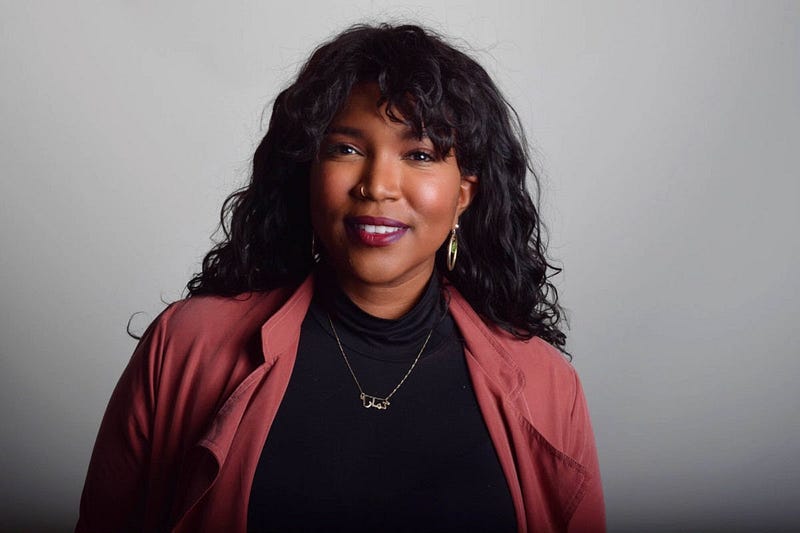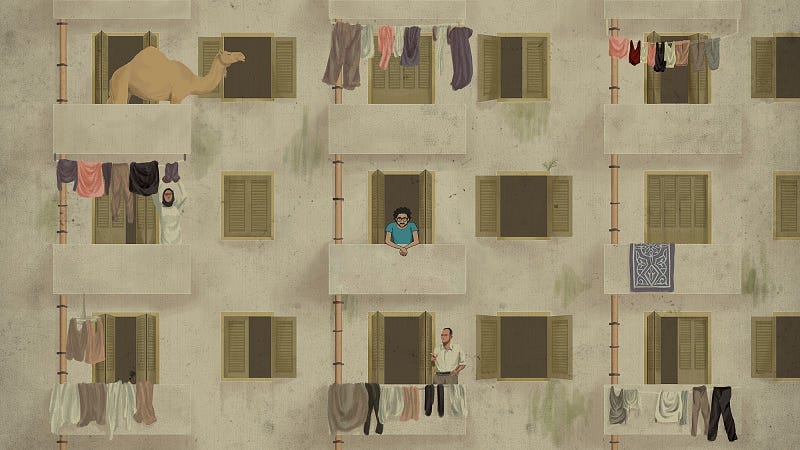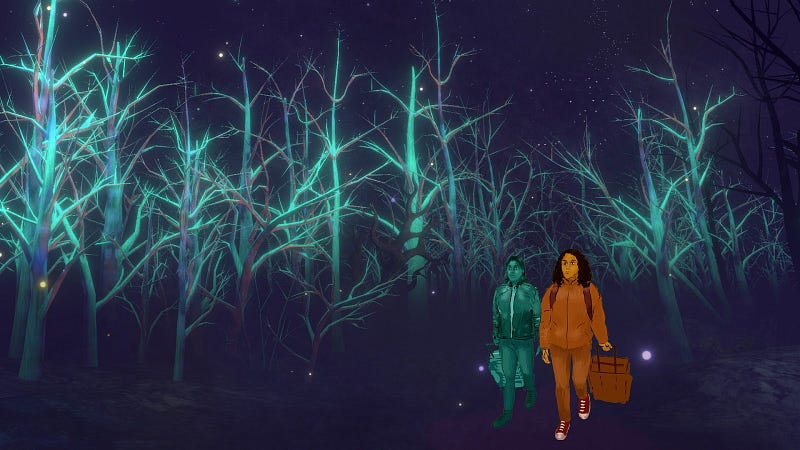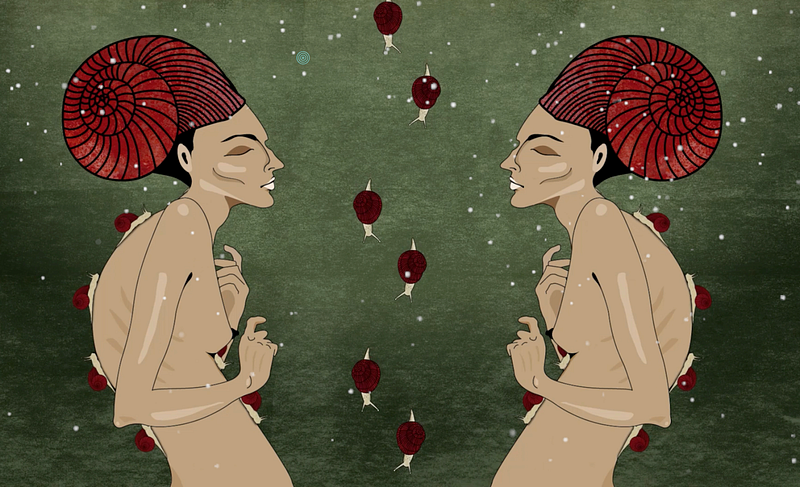An interview with filmmaker and new media artist Tamara Shogaolu about her transmedia series “Queer in the Time of Forced Migration,” her upcoming installation with FRONTLINE and designing for COVID-safety
 Tamara Shogaolu
headshot
Tamara Shogaolu
headshotTamara Shogaolu is a filmmaker and new media artist sharing intersectional stories across mediums, platforms, and virtual and physical spaces. I spoke with her about a project that she recently wrapped after 11 years: the powerful 3-part animated transmedia series Queer in the Time of Forced Migration. This project follows LGBTQ+ refugees and asylum seekers from the Middle East and North Africa and their journeys to Europe, and has been presented at Tribeca Film Festival, the Museum of Modern Art (MoMa) in New York, and the Museum of Amsterdam. We also discussed her next project, an installation with FRONTLINE called Un(re)solved.
Queer in the Time of Forced Migration begins with Half a Life, a short animated documentary following a gay Egyptian activist and his decision to leave Cairo. The second piece in the series is Another Dream, a hybrid animated documentary and VR game about a lesbian couple that escapes Egypt to seek aslyum and acceptance in the Netherlands. I experienced this piece when it premiered at Tribeca in 2019, and enjoyed interactive elements like tracing words in Arabic to transition between scenes. The final part of the series is They Call Me Asylum Seeker, a web-based interactive experience released in 2020 that follows the aforementioned main characters from the Egyptian Revolution in 2011 through their experiences as political refugees in Europe. Shogaolu’s production studio Ado Ato Pictures shared the piece with me before our conversation.
 Still from Half a Life, the first
installment of the series Queer in the Time of Forced Migration
Still from Half a Life, the first
installment of the series Queer in the Time of Forced Migration
What first captivated me about this series was the powerful storytelling — how it challenges and expands conceptions of home, and examines and highlights what it means to exist at various intersections. I was also interested in the multimodality of Shogaolu’s work; this series deftly traverses 2D animation to VR to web-based interactive, and Shogaolu’s other work, domes, AR, and installation.
This interview has been edited and condensed for clarity.
Immerse: How did Queer in the Time of Forced Migration start, and why you were interested in telling this story?
Tamara Shogaolu: In my past life, I had a Fulbright in Egypt, and I spent almost a third of my life at that point living in the Middle East and doing research on labour economics. When the Egyptian revolution happened in 2011, an Egyptian journalist friend and I decided that we wanted to travel around the country to collect oral histories. We interviewed women from ethnic and religious minorities, asylum seekers in Egypt, and members of the LGBTQ+ community. I noticed a huge backlash focused on the LGBTQ+ community in Egypt, and a lot of friends of mine who had never expressed any interest in leaving Egypt were being forced to leave. When I saw the news coverage of the “migrant crisis” and refugee stories, I knew that my friends’ stories weren’t a part of the mass story, so I felt an obligation to share them.
I continued collecting more and more oral histories, and I ended up recording the lives of these individuals over a span of 10 years. There was so much material that I decided I didn’t want to cut things to have it fit into a traditional film format. I decided to turn it into a series and break it down into something that could exist in different platforms.
Immerse: Why did you choose to exclusively use animation for this series?
TS: Before the revolution, people didn’t really speak openly about these issues in Egypt or in the Middle East. People were more likely to open up and have real conversations if you recorded the audio, versus having a camera in front of them. The way to visually represent that became animation. We wanted to protect the identities of the individuals in the story.
Immerse: How did you choose which mediums and technologies to use for each part of the series?
TS: When I started the series, VR wasn’t a huge thing. The biggest thing at the time was web documentaries. For the first part of the series, I didn’t feel that doing a web documentary would be the strongest approach, so I decided to make an animated documentary, called Half a Life. I saved some money for it, did it with friends, and was able to complete an animated film.
 Still from Another Dream, the second
installment of the series Queer in the Time of Forced Migration
Still from Another Dream, the second
installment of the series Queer in the Time of Forced MigrationBecause of the success of Half a Life, there was more opportunity to build on the second piece, Another Dream. By that time, better headsets had come out and technology for VR had advanced a lot. I also decided on the VR game format from talking to the women who the story focuses on, who are super into gaming and technology. I discussed it with them, and they were super excited about it, so I thought that that would add another layer of meaning.
The final part, They Call Me Asylum Seeker, was originally designed to be a location-based experience, but we weren’t able to finish it because of the pandemic. We got a commission from Open City Documentary Festival in London to adapt it for the web for their 2020 program, so we decided to make a web interactive long-form doc with some hybrid game qualities. And then, ironically enough, we were able to adapt the web-adaptation of a location-based experience into a physical place, because we have a museum exhibition going on now. So I thought that was very meta.
 Still from They Call Me Asylum
Seeker, the third and final installment of the series Queer in the Time
of Forced Migration
Still from They Call Me Asylum
Seeker, the third and final installment of the series Queer in the Time
of Forced MigrationImmerse: That does sound very meta. I’d love to hear more about the museum installation.
TS: There’s an exhibition at the Amsterdam Museum called Refresh. It has pieces that relate to identity and your connection to home, and what home means. It’s the first time I’ve exhibited all three pieces in one place.
Because of COVID, we had to adapt the VR experience. We built a mini-dome with a 360 projection, so people can sit under the dome and see the projections around them. We didn’t want to lose the immersive spatial sound, so we had to build something that goes over people’s heads, so that you still feel like you’re wearing headphones without having to touch anything.
 Tamara Shogaolu at the Refresh
exhibit in the Amsterdam Museum
Tamara Shogaolu at the Refresh
exhibit in the Amsterdam MuseumImmerse: Why was it important to you to tell these stories?
TS: When I started making the series, it was more about seeing what was happening in the community and seeing friends of mine being persecuted. As it evolved, I realized that it also became about representation. I think the most rewarding experiences I’ve had had with showing this project are people coming up to me and telling me that they feel seen, you know?
During the installation, I think one of the most beautiful moments I had was when I overheard this young woman talking with her friends. There’s a poem in Arabic that inspired the series, printed on the wall of the museum, and she started telling her friend what the poem said. She started taking photos with the poem, and then she started telling her friend, “Yeah, this is my story.” I started talking to her and I learned that she was an LGBTQ+ refugee from Sudan, and she actually knew one of the characters. It was just so amazing to see somebody feel emboldened to take ownership of the piece.
Immerse: It’s so interesting to hear about how you’re bringing this transmedia series with the VR and web doc elements into an installation where people can view it collectively, even though it sounds like it’s closed now due to COVID.
TS: Yes, I’m also doing an installation with PBS FRONTLINE. It’s an AR installation with living quilt panels that I started designing during the pandemic. So COVID-safety was at the forefront.
I was really inspired by African American quilting traditions. Some historians even speculate that a path for the underground railroad was stitched onto quilts. And it’s something that has been really important in recording history. So this project is about the investigation behind 151 potentially racially motivated murders in America.
The installation is meant to function as a memorial of sorts, in a way to allow people to remember these people, explore their stories, and make us all reflect and think about, why aren’t these cases solved? Which is why it’s called Un(re)solved. There are these intimate pieces, and you’re able to read the case summaries of the people and learn more about their lives. And audiences are invited to say the name of the person when they enter the installation. So the idea is that there’s a cacophony of sounds and you will be able to hear all the names, if you have different people at different panels.
Immerse: How do you consider accessibility in your immersive work?
TS: I try to design things in a way that they’re scalable. With the FRONTLINE team, they’re looking into incorporating loaner devices at that installation when it’s shown. So you don’t have to have a phone in order to experience it. I think that lowering those barriers will also expand the field in general.
Immerse: It sounds like you’ve been doing a lot of thinking about different ways stories can be experienced during the pandemic. What do you think is the future of how people will be experiencing immersive media together?
TS: I think location-based, 100%. My production studio has actually developed a location-based interactive platform called Bemmbé, which allows people to interact with stories through physical interactions. People are going to want to be places, they’re going to want to come together. At least, that’s where I’m at, and that’s what I want to be doing. I tend to try and make things that I would want to experience with my friends. We spend so much time so connected to our gadgets as the only way to connect with one another, that I think that maybe we’ll see a shift in how tech and devices will become part of how we interact with the world.
For more news, discourse, and resources on immersive and emerging forms of nonfiction media, sign up for our monthly newsletter.
Immerse is an initiative of the MIT Open DocLab and receives funding from Just Films | Ford Foundation and the MacArthur Foundation. The Gotham Film & Media Institute is our fiscal sponsor. Learn more here. We are committed to exploring and showcasing emerging nonfiction projects that push the boundaries of media and tackle issues of social justice — and rely on friends like you to sustain ourselves and grow. Join us by making a gift today.